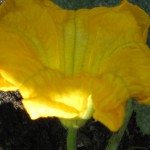Flowers but no squash?
Posted on August 19th, 2009 by Phuong
So your vegetable plants are growing luscious and green and are producing a fair amount of flowers, but for some reason you’re not getting fruit set. No pumpkins, squash, ears of corn or tomatoes. What’s going on? A key problem is pollination. Your plant either hasn’t been pollinated at all, or has been insufficiently pollinated.
reason you’re not getting fruit set. No pumpkins, squash, ears of corn or tomatoes. What’s going on? A key problem is pollination. Your plant either hasn’t been pollinated at all, or has been insufficiently pollinated.
Cucumbers, melons and squash have both male and female blossoms on the same plant (with the exception of some varieties). The female blossom must be pollinated by the male ones in order for fruit to set; only the female blossoms produce fruit. The first blossoms you’ll see are male (they have thin straight stems), to be followed by the female (usually further out on the vine, larger and have an undeveloped fruit at their base — it looks like a little bulbous thing). These plants rely on bees to pollinate. Bees do such important work in our vegetable gardens, so try to avoid insecticides where possible and plant flowers throughout to invite them into your garden. (See our earlier post on bee-friendly gardens).
If you have a lot of blossoms but no fruit, you can wait for the bees to do their thing, or you can take matters into your own hands. Here’s some advice from the Spokane County WSU extension program:
To hand pollinate vine crops, locate the male blossoms. Break off several from the plant and peel back the petals. Note the pollen on the inside of the blossom. Gently push the pollen into the female blossoms with a paintbrush, a feather, or the male blossom itself. This should insure a good crop.
Filed under:Seattle Landscape Maintenance | Permalink |



